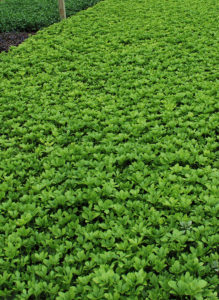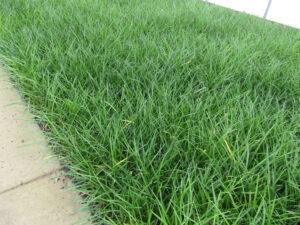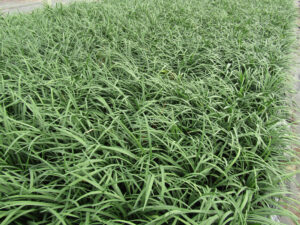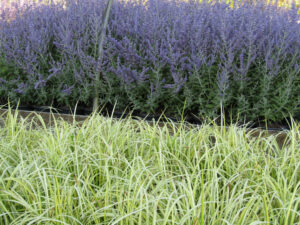
In this modern age of natives and nativars and back-to-the-earthers and ideological purists, it is only the brave, or possibly only the foolhardy, who advertise Asiatic Plants. It took only a few minutes of calm reflection for me to realize that our biggest seller and highest profitable plant is something with the common name of “Japanese Spurge”, thus it would be difficult for me to come off as a purist. Besides, the market determines what we grow and we grow what sells, not needing a hobby at this stage in life, although sometimes I grow a few of my favorite plants, just because.
Anyhow, today the operative plant is Liriope spicata, common name, Creeping lily-turf, which is sometimes called invasive when it is merely vigorous having lots of rhizomes. They tell me that for a plant to be truly invasive it needs to make seeds that the animals spread all around. The best thing about L. spicata is that it grows really thickly and thus seldom has a weed problem and it works in those traffic islands around and in parking lots and it does not need to be mowed and it is green. What more could a person want. It does best in moist sites and so the above-mentioned parking lot islands where the soil structure usually consists of compacted clay courtesy of bulldozers is a good habitat.

Our competitive advantage is that we grow our own out in the field, in both heavy soil and in blow sand with irrigation, and therefore when we divide it we can make as small a division as we want. Thus we offer this fine plant in a 2 ½” plastic pot—the SVD one, or for the same price per unit, in a 32 plug which has a slightly less soil volume but the same depth and is more convenient to handle out on the job site. We also grow it in the 4” ten count that used to be a 4 ½” and then before that was a quart. This plastic stuff shrinks over time. It is like buying a candy bar. And we grow it in a one gallon pot, that used to be a three quart pot and now is a 2 ½ quart pot popularly known as a Number One pot. We are just trying to be like everyone else in the trade.

Because this is a near-ideal plant for us to grow—stock can be stored in the field and it involves a lot of hand labor to make and it keeps well in the container, only getting bigger and thicker with age—we like to always have a good supply on hand. Sometimes we run a little short in one size or the other and this leads to a lot of finger pointing around the nursery and character deprecations abound as we try to figure out who messed up the production schedule or, more commonly, who forgot to follow the production schedule. I always come out clean during these intra-mural spats because I have both a highly selective memory and, at my age, a good excuse for the memory being selective. What has confused us in the past is how rapidly the market appears to be growing. We are starting to be more pro-active these days in making sure we have a constantly good supply.
Liriope spicata is hardy in Chicago. Its cousin, Liriope muscari ‘Big Blue’ is not as hardy and also not as prolific a grower as it is more clump forming. I do not like it but am learning how to optimize its growth so that we will not run out of it either. And then we will not have to deal with those people in Louisana who grow the liners there.

Speaking of Asiatic Plants, I am always trying to unload upon the unsuspecting public something called Acorus gramineus ‘Ogon’, grassy-leaved sweet flag. Its main attribute is its shockingly bright yellowish color. It also grows in water if that is what you like. For reasons that I cannot remember (refer to the memory problem mentioned heretofore) we have all kinds of stock of this plant. It can be divided any day of the year and if it ever sold it would be the near-ideal plant. We do not keep much in stock in pots as it grows kind of fast, so will need a little lead time to get it established in a pot when someone gets the urge to purchase.
The beauty of both of these Asiatic exotics is that they are about the same height as a healthy stand of lawn grass and they do not need to be mowed, except after some of the hard winters one will want to run a weed whacker over the black tips of the foliage blades to spiffy things up.
